The third century was a tough time to be a woman, but the warrior Lady Trieu didn’t really seem to notice. This tough-as-nails heroine rejected domesticity and rose through army ranks to become one of the fiercest freedom fighters in the East. From her greatest exploits to her tragic end, here are 42 facts about bold Lady Trieu.
1. Legend Has It
It’s very difficult to get ahold of any sure information about Lady Trieu or her incredible story. Although some historical Vietnamese texts include her feats of strength and her many hard-won victories, their claims come centuries after her passing and can’t always be trusted. So fair warning: take these facts with a grain of salt.

2. By Any Other Name
Lady Trieu’s real name has been lost to history, though some sources refer to her as “Triệu Thị Trinh.” Though it’s hard to transliterate her name into English, it would sound something like “Jeu Tea Chin” to us.
3. Silver Spoon
Trieu was born around 243 AD in the Nông Cống district of Vietnam. Her family was reportedly wealthy, and baby Trieu lived comfortably—for a time, at least.
4. Under the Thumb
Lady Trieu was an oppressed subject all her life. Imperial China invaded Vietnam during the terrifying Han dynasty in 43 AD, and they ruled the country with an iron fist for centuries, long before Trieu was even born. Yet from a young age, she was acutely aware of her people's suffering, particularly the peasants who lived below her station.
5. Little Orphan Trieu
These dire circumstances were far from the only tragedies faced by young Trieu. When she was still just a little girl, both her mother and her father perished, leaving her orphaned and nearly alone. Struggling to survive, Trieu moved in with her older brother Trieu Quoc Dat and tried to make the best of an utterly terrible situation.
6. It’s a Long Story
Bizarrely, descriptions of Lady Trieu say that she had pendulous bosoms that were over a meter long. Apparently, Trieu would tie her massive appendages behind her back when she had to fight. True? Probably not—but a girl can dream.
7. Golden Girl
In a more likely report, sources also claim that Lady Trieu had a flair for drama on the battlefield. She loved riding elephants into battle and preferred to wear golden yellow tunics just to make sure her enemy knew exactly whom they faced in the trenches. To top it all off, she decorated her hair with golden hairpins and wore luxurious ivory clogs on her feet.
8. A Well-Rounded Woman
Ancient texts describe Trieu as uncommonly witty, physically strong, and endlessly brave.
9. Oh Boy
Lady Trieu was always a bit of a tomboy, and she never wanted to sit still or look pretty as a domesticated woman. As she once told her brother, “I will not resign myself to the lot of women who bow their heads and become concubines.”

History's most fascinating stories and darkest secrets, delivered to your inbox daily.
10. A Show of Force
During Trieu’s time, the Eastern Wu dynasty was in charge of China—and in 226, the Taizu Emperor of Wu decided that Vietnam needed to be reminded of his Imperial might. China swiftly and cruelly purged many of Vietnam’s high-ranking leaders and rulers. When an inevitable uprising stirred, they began slaughtering thousands of Vietnamese people.
11. Rebel, Rebel
Angry at the brutal Chinese interference, Lady Trieu took refuge in the mountains. The bossy, charismatic young woman—then only 19 or 20 years old—quickly attracted a loyal band of 1,000 followers. With this power behind her, Lady Trieu started planning her rebellion against the tyrannical Imperial Chinese forces.
12. Let’s Get Down to Business
Lady Trieu reportedly trained all these 1,000 men by herself.
13. All in the Family
Hot-blooded genes ran in the Trieu family. Whether he was inspired by his baby sister or came to it on his own, her brother Trieu Quoc Dat also became a rebel.
14. Sister Act
Lady Trieu’s rebellion was hardly the first time a woman faced down Imperial China. Centuries before Trieu’s time, the two Trung Sisters rose up against the very first Chinese invaders in 40 AD, becoming heroines in their own right.
15. A Tall Drink of Water
According to the legends, Lady Trieu stood at an intimidating nine feet tall.
16. Woman on Top
Though he was initially protective of his baby sister, Trieu Quoc Dat eventually recognized Lady Trieu’s valor and paid her an incredible honor. He made her the leader of one of the battalions. While there, she quickly established herself as one of the most capable and fearless fighters in the rebellion, above and beyond many of the seasoned men under her.
17. 30th Time’s the Charm
In total, Lady Trieu led her men in a whopping 30 battles against the Chinese around the year 248 AD.
18. Forgotten History
Though Chinese sources mention rebel forces in a 248 AD revolt, they make no mention of Lady Trieu by name. Instead, the documents mostly focus on the Chinese forces' victories over the pesky rebels. According to one historian, this was due to a devastating insult. To the Chinese, Lady Trieu was "simply a kind of stubborn barbarism…and was of no historical interest.”
19. Remember My Name
Because of her penchant for yellow robes and her rather healthy ego, Lady Trieu named herself Nhụy Kiều Tướng quân or “The Lady General Clad in Golden Robes.” You know you’re a boss lady when you give yourself a nickname.
20. Can You Hear Me Now?
Apparently, this nine-foot-tall woman with enormous drooping bosons was also an astonishing beauty. Men would shake in their boots to see her face, and her voice was compared to a clear temple bell. Probably all the better for ordering her men around, giving herself awesome nicknames, and making rousing speeches from all the way across the battlefield.
21. An Army Marches on Its Stomach
Among her many other accomplishments, it’s said that Lady Trieu could walk 500 leagues a day—no small feat for anyone, woman or man. Probably related to all the walking, Trieu was also something of a professional eater. Apparently, she could pack away a hefty amount of rice every day. After all, mercilessly raiding and pillaging the enemy is hard, hungry work for a growing girl.
22. Who Run the World?
When Lady Trieu first burst onto the battlefield, the Chinese authorities didn’t take her seriously. A woman fighter wasn’t worth their notice, and they assumed she’d simply crumble under the pressures of leadership and the fog of battle. They quickly found out how wrong they were. It’s said that they soon flew into frenzy whenever they heard Lady Trieu was leading the charge.
23. Eye of the Tiger
After the Chinese got a true taste of Trieu, they reportedly feared her very gaze. A common phrase even stated that, “it would be easier to fight a tiger than it would be to face Lady Trieu in battle.”
24. Brother Where Art Thou
Sadly, Lady Trieu’s brother Trieu Quoc Dat was slain in battle in the middle of the conflict. He had been with her since the very beginning, but Trieu continued on like the soldier she was, even taking up leadership of the army her beloved brother once commanded.
25. Hullo, Governor
Eventually, Lady Trieu’s men had the whole region of Giao Chau in Vietnam cowering in fear. The underdog rebels even succeeded in slaying Giao Chau’s governor. The surprise victory garnered Trieu many more supporters, with crowds of young men from neighboring regions lining up to fight under the woman warrior in the golden robes.
26. Arch-Nemesis
Lady Trieu’s most bitter rival on the Chinese side was the sinister Inspector Luc Yin. He was an army general who came from a battle-hardened family with powerful and influential connections to Imperial China. When the tide started turning in Trieu’s favor, the Emperor sent the crafty Inspector with 8,000 men to crush the rebellion once and for all.
27. Clear Eyes, Full Hearts, Can’t Lose
Against all odds, Lady Trieu’s motley, rebellious crew managed to hold off Lu’s forces for months on end, giving one of the most powerful nations in the world a run for their money.
28. Fight to the End
Sadly, it all came to an utterly tragic end. After five or six months of fighting, the rag-tag group were frighteningly low on resources and morale. They simply didn’t have enough reserves to fight a long conflict. But Imperial China certainly did. Despite all her perseverance, it was only a matter of time before Trieu broke.
According to one source, Lady Trieu was slain in battle in 248, proving she was human after all.
29. Gone Too Soon
Lady Trieu was only 23 years old when she passed on.
39. The Maid of Vietnam
Trieu’s bravery in battle against an impossibly powerful enemy has led to natural comparisons between her struggle for Vietnam and Joan of Arc’s battle for France. Not only did both women prove their mettle on the battlefield and live on in the legends of their countries, they also both suffered tragically premature deaths.
31. She Lives in You
Lady Trieu’s tragic end was not all in vain. Hundreds of years later in 939, the Vietnamese finally won their bloody conflict against the Chinese and gained independence for over 1,000 years.
32. I Wanna Be Like You
In fact, Lady Trieu’s legacy was very personal. Three hundred years later, when the Vietnamese were still fighting against China, the younger, newer rebels remembered Lady Trieu and drew inspiration from her bravery and dedication.
33. Our Lady of War
The Vietnamese ruling family of the Ly dynasty also recognized Lady Trieu's patriotism and contributions to her country. They honored her with the beautiful posthumous title Bat chinh anh liet hung tai trinh nhat phu nhan. This title has a truly heartrending meaning. In English, the words mean, “Truest and Bravest First Lady.”
34. Rest in Power
King Nam De of the Ly dynasty even commissioned a tomb and temple for Lady Trieu, both of which still stand to this day.
35. Fight or Flight
Though some records posit that Lady Trieu perished in battle, another source claims that she suffered an even darker fate. According to this text, an exhausted Lady Trieu admitted defeat and fled the battlefield in her only recorded act of cowardice.
36. Maid of Honor
Although she ran away from her men in their time of need, Lady Trieu was determined to regain her honor—even if it had horrifying consequences. She ferreted herself away in the Bo Dien commune and, all hope lost, took her own life by throwing herself into a river and letting the raging current take her. Thus she met her end as a heroine.
37. The Sword in the Stone
In the later 20th century, researchers made an astonishing discovery. They unearthed a bronze sword on Mount Nua in the Thanh Hoa province, right where many of Lady Trieu’s battles took place. Even more than that, the blade was carved with a heartbreaking inscription and drawing on its hilt.
The handle showed a finely dressed woman wearing a turban, and the carving read:
Sleep, sleep tight my child
So that I can fetch water to wash the gilded saddle of the elephant.
Climb the hill if you want to watch
Lady General Trieu on her golden gilded seat.
38. Grudge Match
When Lady Trieu was barely out of her teenage years, she showed her true, bloodthirsty colors. Reportedly, her brother’s wife was incredibly cruel to the young woman, so the vengeful Lady Trieu started plotting her brutal revenge. When she was 19 or 20 years old, Trieu took the life of her sister-in-law—and the dastardly young lady even got away with it.
39. Fight Like a Girl
There may have been another, more disturbing reason why the Chinese tried to hush up all mentions of Lady Trieu. At the time, Confucian philosophy ruled China, and the doctrines taught strict filial piety and respect for the man of the house. For a woman to break out of the kitchen and defeat their armies in battle was an unimaginable humiliation, and not one the Chinese wanted to record for posterity.
40. Can’t Hold Me Down
Trieu’s brother initially wasn’t happy with his little sister’s rebellious spirit—but when he begged her to reconsider and live a quiet life, Lady Trieu gave him an utterly chilling response. She told him, “I only want to ride the wind and walk the waves...Why should I imitate others, bow my head, stoop over and be a slave? Why resign myself to menial housework?"
Her words have since become a clarion call for brave women everywhere.
41. G.I. Jane
According to modern historians, the large number of female troopers in the Vietnamese army during the Vietnam War may have actually been because of Lady Trieu’s influence, as these women strove to carry on her memory.
42. Where the Streets Have Her Name
Lady Trieu is still celebrated as a hero in modern Vietnam, and there are many streets named after her, including in the capital Ho Chi Minh City.




















































